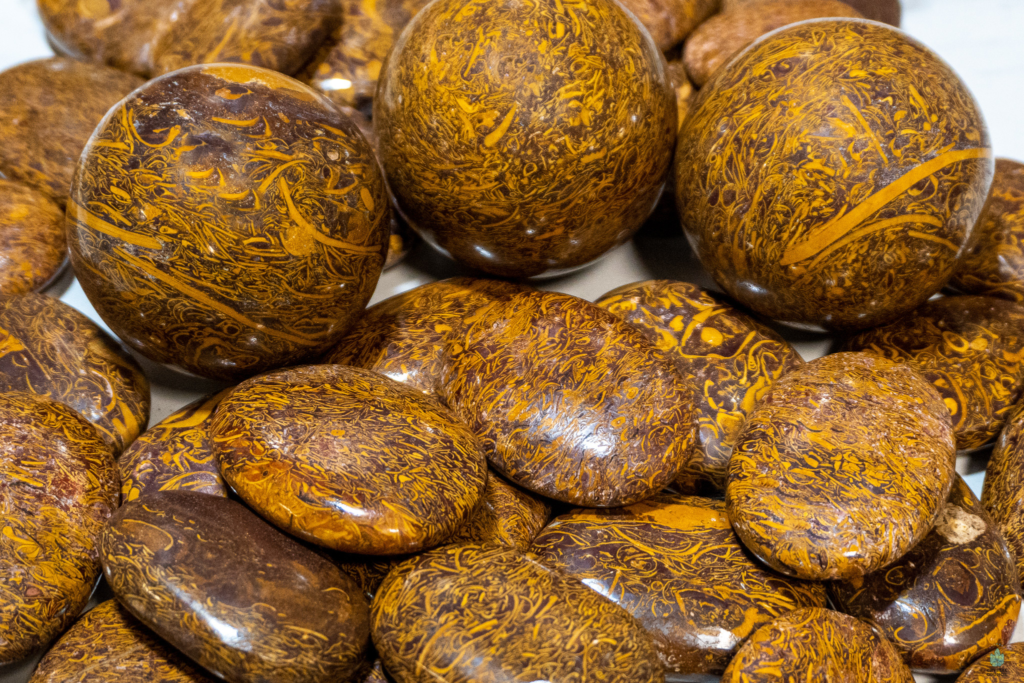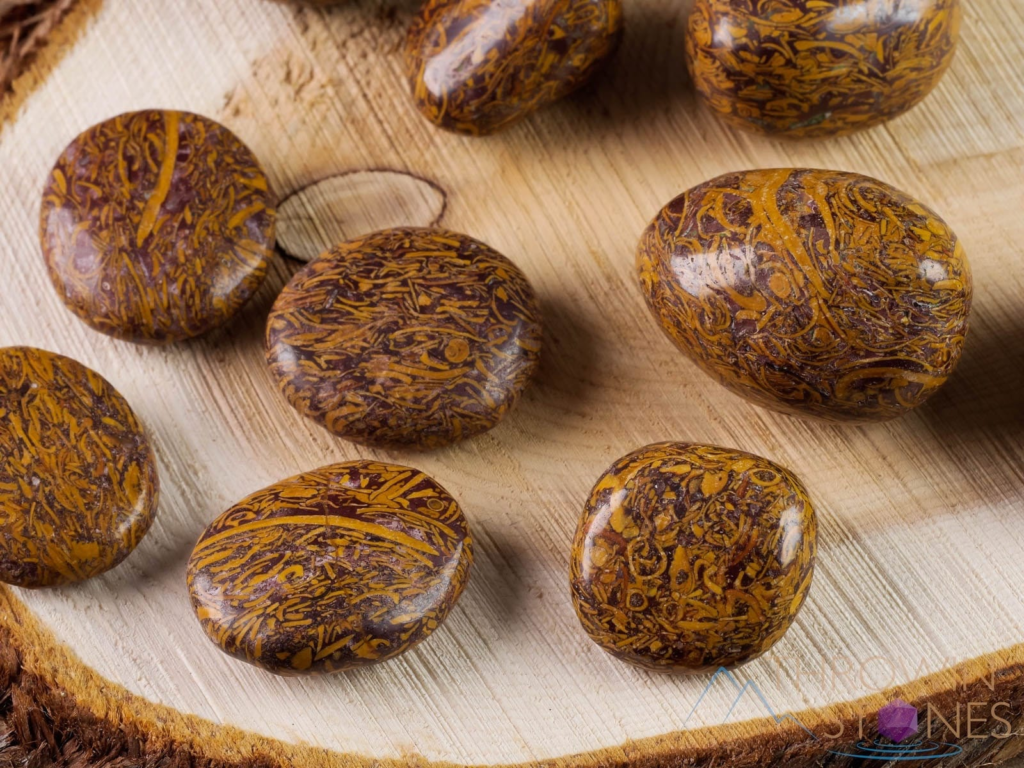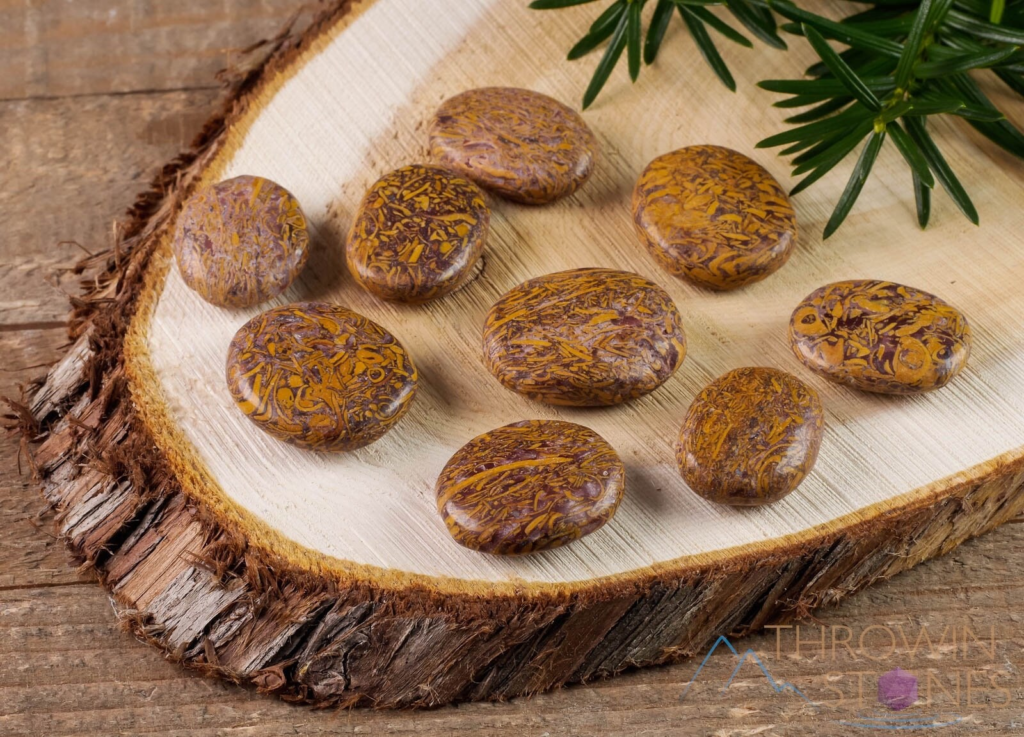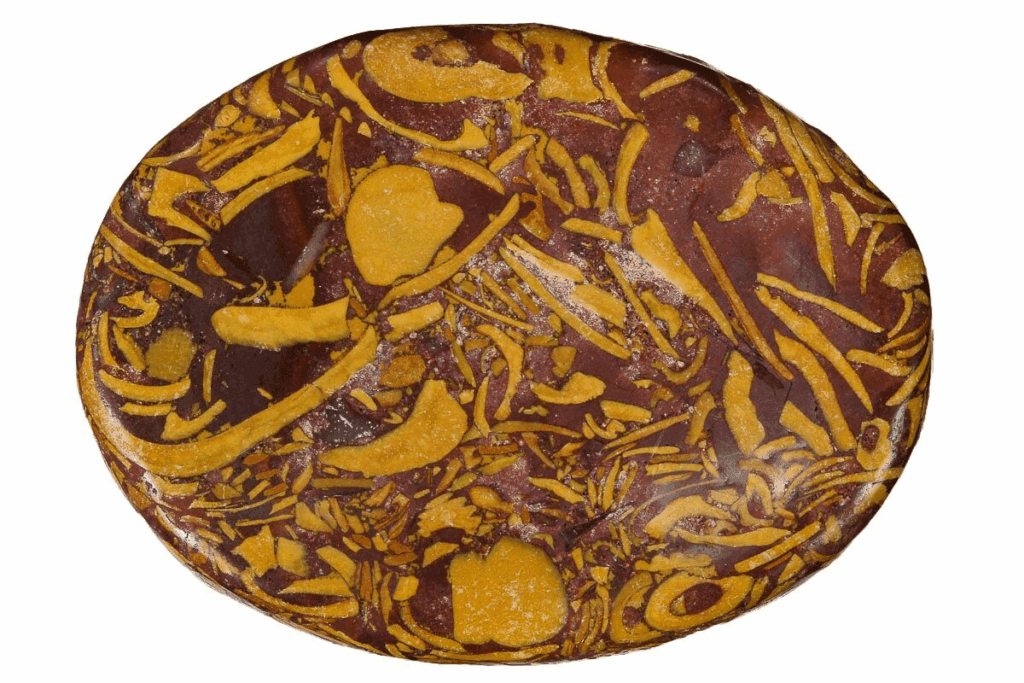Calligraphy Stone, also known as Mariam Stone or Arabic Stone, is a unique type of fossiliferous limestone that features intricate patterns resembling Arabic calligraphy or Chinese brush strokes. It is primarily sourced from the Atlas Mountains in Morocco. The stone’s distinct appearance is attributed to the presence of fossilized sea creatures, primarily Orthoceras, which are ancient cephalopods related to the modern-day squid or nautilus.
The intricate patterns found in Calligraphy Stone are created by the fossilized remains of these marine organisms, which form dark brown to black lines and swirls against a cream or beige background. The contrast between the dark fossilized remains and the lighter matrix creates stunning visual effects reminiscent of elegant calligraphy strokes, hence the name “Calligraphy Stone.”
Due to its unique appearance and aesthetic appeal, Calligraphy Stone is highly prized for use in lapidary and decorative applications. It is often cut and polished into various shapes, including cabochons, beads, and decorative objects. Jewelry designers, collectors, and enthusiasts value Calligraphy Stone for its beauty and its connection to ancient marine life.
Beyond its ornamental uses, Calligraphy Stone is also believed to possess metaphysical properties. Some people associate it with grounding energy, promoting stability, and enhancing communication skills. However, it’s essential to note that these claims are not scientifically proven and are based on personal beliefs and anecdotal evidence.
In summary, Calligraphy Stone is a captivating natural stone renowned for its resemblance to calligraphy and its connection to ancient marine life. Whether admired for its aesthetic appeal, metaphysical properties, or geological significance, Calligraphy Stone continues to fascinate and inspire people around the world.
Geological Formation

The formation of Calligraphy Stone is closely tied to the geological history of the region where it is found, primarily the Atlas Mountains in Morocco. The stone is a type of limestone, a sedimentary rock formed from the accumulation and compaction of marine sediments over millions of years. The intricate patterns seen in Calligraphy Stone are the result of specific geological processes.
Here’s an overview of the geological formation of Calligraphy Stone:
- Deposition: The formation process begins with the deposition of sediments on the ocean floor. These sediments consist of a mixture of organic and inorganic material, including the remains of marine organisms such as shells, corals, and microorganisms.
- Compaction and Cementation: Over time, the layers of sediment accumulate and undergo compaction under the weight of overlying layers. This compaction squeezes out water and air, causing the sediment grains to become tightly packed together. Minerals dissolved in groundwater may precipitate and act as cementing agents, binding the sediment grains together to form solid rock.
- Fossilization: The marine sediments in which Calligraphy Stone forms contain a significant abundance of fossilized remains, particularly those of ancient cephalopods known as Orthoceras. These creatures lived in the ancient seas that covered the region millions of years ago. As sediment accumulates around their remains, the organic material of the organisms undergoes mineral replacement, gradually turning into stone while retaining the shape and structure of the original organism.
- Geological Forces: The Atlas Mountains have been subject to tectonic activity over millions of years, including uplift and folding caused by the collision of tectonic plates. These geological forces can deform and fracture the rock layers, leading to the formation of veins, folds, and other structures within the limestone.
- Weathering and Erosion: External forces such as wind, water, and ice weather and erode the surface of the limestone over time. This natural weathering process exposes the intricate patterns formed by the fossilized remains within the rock.
The combination of these geological processes over millions of years gives rise to the unique characteristics of Calligraphy Stone, including its distinct patterns resembling calligraphy strokes. The fossilized remains of ancient marine life preserved within the limestone are a testament to the geological history of the region and provide valuable insights into past environments and ecosystems.
Geological Composition

The geological composition of Calligraphy Stone is primarily limestone, a sedimentary rock composed predominantly of the mineral calcite (calcium carbonate, CaCO3). However, what makes Calligraphy Stone distinctive is not just its limestone base but also the presence of fossilized marine organisms and the intricate patterns they create.
Here’s a breakdown of the geological composition of Calligraphy Stone:
- Limestone Matrix: The bulk of Calligraphy Stone consists of limestone matrix, which is composed mainly of calcite. Limestone forms from the accumulation and lithification (compaction and cementation) of marine sediments, such as shells, coral fragments, and microorganisms’ skeletal remains.
- Fossilized Organisms: One of the most striking features of Calligraphy Stone is the presence of fossilized marine organisms, particularly Orthoceras, which are ancient cephalopods. These organisms lived in the ancient seas that covered the region millions of years ago. As sediment accumulated around their remains, the organic material underwent mineral replacement, gradually turning into stone while preserving the structure of the original organism. These fossilized remains create dark brown to black lines and swirls against the lighter limestone matrix, resembling calligraphy strokes.
- Other Minerals: In addition to calcite, Calligraphy Stone may contain other minerals present in limestone, such as aragonite, dolomite, and various impurities. These minerals can contribute to the stone’s color variations and overall appearance.
- Veins and Vugs: Within Calligraphy Stone, you may also find veins or vugs (cavities) filled with secondary minerals. These minerals can include calcite, quartz, chalcedony, or other materials deposited by circulating fluids after the formation of the limestone. Veins and vugs add further visual interest and texture to the stone.
Overall, the geological composition of Calligraphy Stone combines the basic components of limestone with the unique addition of fossilized marine organisms and secondary mineral deposits. This distinctive combination gives rise to the captivating patterns and aesthetic appeal for which Calligraphy Stone is renowned.
Physical Properties

The physical properties of Calligraphy Stone contribute to its unique appearance and suitability for various applications. Here are some key physical properties:
- Color: Calligraphy Stone typically exhibits a creamy to beige background color, often with varying shades of tan or light brown. The distinctive dark brown to black patterns, resembling calligraphy strokes, are created by fossilized marine organisms embedded within the stone.
- Texture: The texture of Calligraphy Stone is typically fine-grained due to its limestone composition. It may have a smooth, polished surface when cut and finished, enhancing its aesthetic appeal.
- Hardness: Calligraphy Stone has a hardness ranging from 3 to 4 on the Mohs scale. This means it is relatively soft compared to many other gemstones and minerals, making it susceptible to scratching and abrasion. However, it is still durable enough for use in jewelry and decorative objects with proper care.
- Density: The density of Calligraphy Stone varies depending on its specific composition, including the presence of fossilized remains and secondary mineral deposits. Generally, limestone has a density ranging from 2.5 to 2.7 grams per cubic centimeter (g/cm³).
- Porosity: Limestone, including Calligraphy Stone, is typically porous, meaning it contains numerous tiny pores or voids within its structure. This porosity can affect the stone’s susceptibility to staining and absorption of liquids if not properly sealed or treated.
- Transparency/Opacity: Calligraphy Stone is generally opaque, meaning light does not pass through it. The opaque nature of the stone enhances the contrast between the lighter background and the darker fossilized patterns, creating a visually striking appearance.
- Fracture: Calligraphy Stone exhibits a subconchoidal to uneven fracture, which means it tends to break with irregular, rough surfaces rather than smooth, flat planes. This fracture pattern is characteristic of many sedimentary rocks, including limestone.
Understanding these physical properties is essential for assessing the suitability of Calligraphy Stone for specific applications, such as jewelry making, lapidary work, or decorative use in architectural and interior design. Additionally, proper care and maintenance considerations, such as sealing porous surfaces and protecting against abrasion, should be taken into account to preserve the stone’s appearance and integrity over time.
Distribution and Occurrence

Calligraphy Stone, also known as Mariam Stone or Arabic Stone, is primarily sourced from the Atlas Mountains region in Morocco. The Atlas Mountains span across Morocco, Algeria, and Tunisia, but the most significant deposits of Calligraphy Stone are found in the Moroccan portion of the range.
Within the Atlas Mountains, Calligraphy Stone is typically extracted from sedimentary rock formations that date back millions of years to the Paleozoic and Mesozoic eras. These formations contain limestone deposits where the fossilized remains of ancient marine organisms, particularly Orthoceras cephalopods, are preserved.
The specific locations within the Atlas Mountains where Calligraphy Stone is mined may vary, but it is often found in areas with accessible limestone deposits. Mining operations may involve quarrying the stone from open-pit mines or extracting it from underground deposits using various methods.
The distribution of Calligraphy Stone outside of Morocco is limited, as the Atlas Mountains are the primary source of this unique stone. However, due to its popularity among collectors, lapidaries, and artisans worldwide, Calligraphy Stone is exported from Morocco to different countries for use in jewelry making, lapidary work, decorative objects, and architectural applications.
In recent years, with the rise of online commerce and international trade, Calligraphy Stone has become more accessible to enthusiasts and consumers outside of Morocco. It is often sold through specialized gem and mineral dealers, online marketplaces, and jewelry stores catering to those seeking unique and exotic gemstones and minerals.
Overall, while Calligraphy Stone’s distribution is centered around the Atlas Mountains in Morocco, its popularity has made it a sought-after material in the global market, reaching collectors and artisans around the world.
Geographic Locations

Calligraphy Stone, also known as Mariam Stone or Arabic Stone, is primarily sourced from the Atlas Mountains region in Morocco. Within Morocco, there are several specific geographic locations where Calligraphy Stone is mined and quarried. Some of these locations include:
- Tazoult Province: This province is located in the eastern part of Morocco, within the Atlas Mountains. It is known for its rich geological diversity, including limestone formations where Calligraphy Stone can be found.
- Agdz: Agdz is a town situated in the Draa Valley region of southeastern Morocco, nestled between the Atlas Mountains and the Anti-Atlas Mountains. The area is known for its geological formations, including limestone deposits that yield Calligraphy Stone.
- Tafraoute: Tafraoute is a town located in the Anti-Atlas Mountains region of Morocco. While the Anti-Atlas Mountains are primarily known for their rich mineral deposits, including various types of agates, Tafraoute and its surrounding areas also contain limestone formations where Calligraphy Stone can be found.
- Rissani: Rissani is a town located in the eastern part of Morocco, near the borders with Algeria and the Sahara Desert. The region is known for its geological formations, which include limestone deposits that may yield Calligraphy Stone.
- Imsouane: Imsouane is a coastal village situated in the central part of Morocco, along the Atlantic Ocean. While the village itself is not known as a major source of Calligraphy Stone, the surrounding Atlas Mountains may contain deposits of the stone.
These geographic locations within the Atlas Mountains and surrounding regions are where Calligraphy Stone is primarily mined and quarried. However, the stone’s distribution may extend beyond these specific areas within Morocco, as it is exported and traded internationally to reach consumers and artisans around the world.
Uses and Applications

Calligraphy Stone, with its unique patterns and aesthetic appeal, is used for various purposes across different industries. Some of the common uses and applications of Calligraphy Stone include:
- Jewelry: Calligraphy Stone is often cut and polished into cabochons, beads, pendants, and other jewelry components. Its striking patterns resembling Arabic calligraphy strokes make it a popular choice for statement pieces and artisanal jewelry designs.
- Lapidary Art: Lapidaries and artisans use Calligraphy Stone to create decorative objects, sculptures, and carvings. Its intricate patterns lend themselves well to artistic expression, and the stone can be shaped and polished to highlight its natural beauty.
- Home Décor: Calligraphy Stone is utilized in interior design and home décor applications. It may be used as decorative tiles, countertops, tabletops, or accent pieces in residential and commercial spaces, adding a touch of elegance and uniqueness to the environment.
- Collectibles: Due to its rarity and distinctive appearance, Calligraphy Stone is sought after by collectors of gemstones, minerals, and fossils. Collectors appreciate the stone for its geological significance, as well as its visual appeal.
- Metaphysical and Healing Practices: Some individuals believe that Calligraphy Stone possesses metaphysical properties, such as grounding energy and enhancing communication skills. As a result, it may be used in alternative healing practices, meditation, or as a talisman or amulet.
- Gifts and Souvenirs: Calligraphy Stone products are often sold as souvenirs or gifts, particularly in regions where the stone is mined. Visitors to Morocco and other areas with Calligraphy Stone deposits may purchase jewelry, decorative items, or small keepsakes made from the stone as mementos of their travels.
- Architectural Applications: In architecture and construction, Calligraphy Stone may be incorporated into building facades, feature walls, or ornamental elements. Its unique patterns can add visual interest and a touch of sophistication to architectural designs.
- Educational and Scientific Purposes: Calligraphy Stone is studied by geologists, paleontologists, and researchers interested in the geological history and fossil record of the Atlas Mountains region. It provides valuable insights into ancient marine ecosystems and environmental conditions.
Overall, the uses and applications of Calligraphy Stone span a wide range of industries and interests, from jewelry making and artistry to interior design, collectibles, and scientific research. Its beauty and geological significance make it a cherished material among enthusiasts and professionals alike.





































